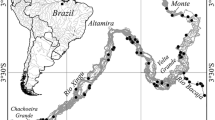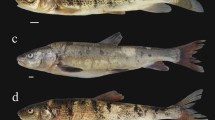Synopsis
Pearl dace, Semotilus margarita, are common in slow-moving channels and pools of the headwaters of the Brokenhead River. From May to September age groups 0, 1 and 2+ were partially segregated in space based on water depth with age 0 occupying shallow pools and shallow channels. Age 1 were abundant in shallow pools and deep channels while age 2+ occurred in deep channels and deep pools. In November all age groups coexisted in deep pools. Pearl dace are omnivorous consuming invertebrates, plant material, and detritus. From May to September age groups 0 and 1 consumed mainly terrestrial invertebrates (Diptera, Hymenoptera, Thysanoptera) but age 1 consumed more detritus than age 0. Age 2+ consumed mainly aquatic Diptera larvae. Although all ages consumed aquatic insects almost exclusively in November differences in diet between age groups still existed. Younger fish fed higher in the water column than older fish. Intraspecific resource partitioning of food and space occurs between age groups and this combined with the omnivorous diet is highly adaptive to the headwaters of streams.
Similar content being viewed by others
References cited
Gee, J.H. 1972. Adaptive variation in swimbladder length and volume in dace, genus Rhinichthys. J. Fish. Res. Board Can. 29: 119–127.
Gibbons, J.R.H. & J.H. Gee. 1972. Ecological segregation between longnose and blacknose dace (Genus Rhinichthys) in the Mink River, Manitoba. J. Fish. Res. Board Can. 29: 1245–1252.
Hart:mann, G.F. 1963. Observations on behaviour of juvenile brown trout in a stream aquarium during winter and spring. J. Fish. Res. Board Can. 20: 769–787.
Hutchison, G.E. 1959. Homage to Santa Rosalia, or why are there so many kinds of animals? Amer. Natur. 9: 145–149.
Hyatt, K.D. 1979. Feeding strategy. pp. 71–119. In: W.S. Hoar, D.J. Randall & J.R. Brett (ed.) Fish Physiology, Vol. VIII, Academic Press, New York.
Hynes, H.B.N. 1950. The food of freshwater sticklebacks (Gasterosteus aculeatus and Pygosteus pungitius), with a review of methods used in studies of the food of fishes. J. Anim. Ecol. 19: 31–50.
Hynes, H.B.N. 1970. The ecology of running waters. Univ. of Toronto Press, Toronto, 555 pp.
Keast, A. 1977a. Mechanisms expanding niche width and minimizing interspecific competition in two centrarchid fishes. Evolutionary Biology 10: 333–395.
Keast, A. 1977b. Diet overlaps and feeding relationships between the year classes in the yellow perch (Perca flavescens). Env. Biol. Fish. 2: 53–70.
Lalancette, L. 1977. Croissance, reproduction et regime alimentaire du mulet perle, Semotilus margarita, du Lac Gamelin, Quebec. Le Naturaliste Canadien 104: 493–500.
Langlois, T.H. 1929. Breeding habits of the northern dace. Ecology 10 161–163.
Loch, J.S. 1969. A description and general biology of the northern pearl dace, Semotilus margarita nachtriebi, With an introductory discussion of taxonomic principles. M.A. Thesis, Dept. Zool. Univ. Toronto, Toronto. 34 p.
Morisita, M. 1959. Measuring of interspecific association and similarity between communities. Mem. Fac. Sci. Kyushu, Univ. Serv. E. (Biol) 3: 65–80.
Moshenko, R.W. & Gee, J.H. 1973. Diet, time and place of spawning, and environments occupied by creek chub (Semotilus atromaculatus) in the Mink River, Manitoba. J. Fish. Res. Board Can. 30: 357–362.
Pianka, E.R. 1969. Sympatry of desert lizards (Ctenotus) in Western Australia. Ecology 50: 1012–1030.
Ricker, W.E. 1937. The food and the food supply of sockeye salmon (Oncorhynchus nerka Walbaum) in Cultus Lake, British Columbia. J. Fish. Res. Board Can. 3: 450–468.
Schoener, T.W. 1974. Resource partitioning in ecological communities. Science 185: 27–39.
Tallman, R.F. 1980. Environments occupied, indices of maturity, feeding ecology, shoaling behaviour, and interactions with other species by pearl dace, Semotilus margarita (Cope) in Manitoba. M.Sc. Thesis, Univ. of Manitoba, Winnipeg. 74 pp.
Author information
Authors and Affiliations
Rights and permissions
About this article
Cite this article
Tallman, R.F., Gee, J.H. Intraspecific resource partitioning in a headwaters stream fish, the pearl dace Semotilus margarita (Cyprinidae). Environ Biol Fish 7, 243–249 (1982). https://doi.org/10.1007/BF00002499
Received:
Accepted:
Issue Date:
DOI: https://doi.org/10.1007/BF00002499




